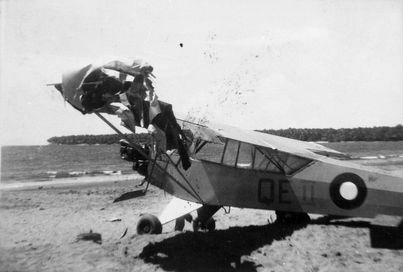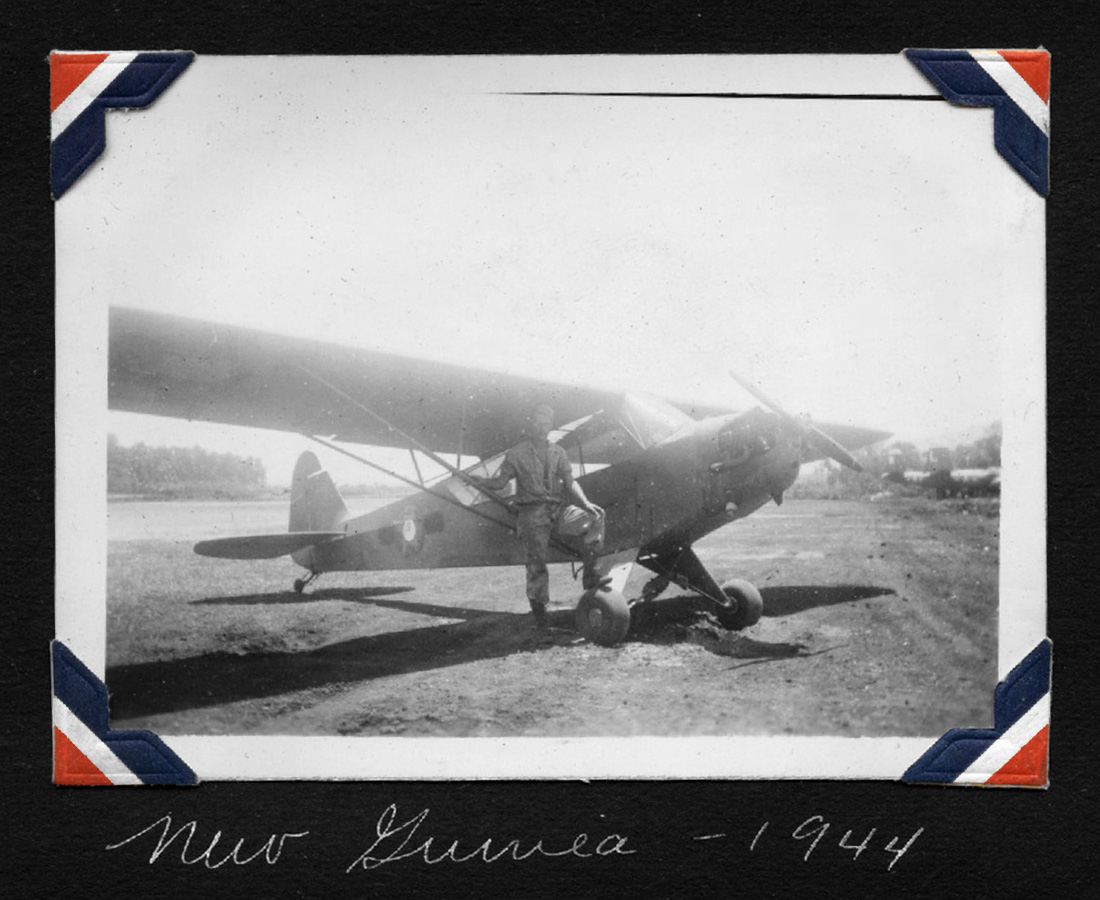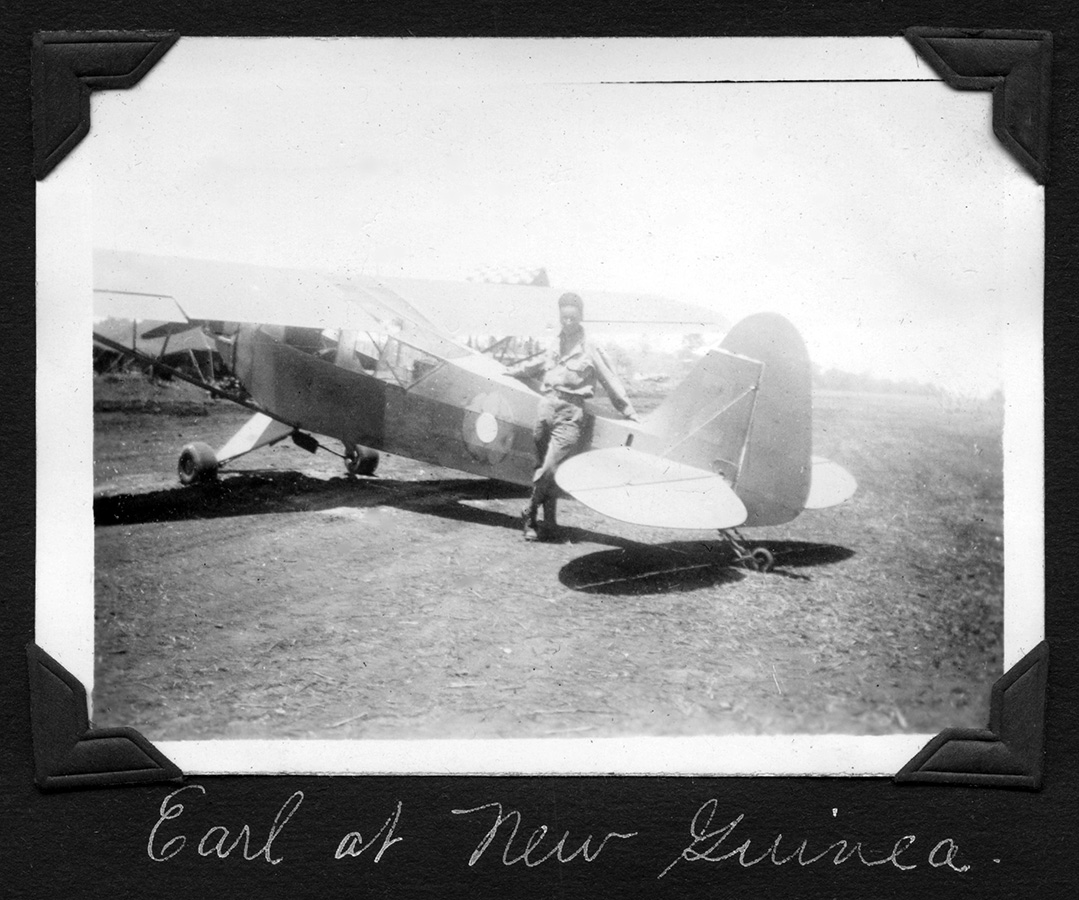RAAF Piper Cubs - a new look
by Steve Mackenzie
Back in issue 25/4 (12-13 years ago) RAAF Oddity #37 presented the small amount of info that was then available on RAAF L-4 Piper Cubs. More info and photos have become available since then and I have combined it with the text and photos from the original article to formulate this update.

This appears to be two Army 'bods', who were regular visitors to 4 Sqn in New Quinea, with one of the Cubs. I suspect that this is QE-II (see below) as it has the same odd demarcation of the White just ahead of the tailplane. Photo: via Peter Malone.
One of the lesser known oddities operated by the RAAF in WW.II were a number of Piper Cub airframes on loan from the US Army/ USAAF. Both Dick Hourigan and Peter Malone provided copies of the small amount of info and photos that they held on the subject at my request. Dick Hourigan advised - 'You asked for the 4 Sqn Piper Cub photo, enclosed is a view of 'QE-II' (attached here as 3.jpg - Steve). I believe that it is standard Olive Drab over Neutral Grey with Blue/ White national markings, White empennage and Sky Blue code letters. This photo and other details came from the pilot Greg Sherman who advised that 4 Sqn had 5 Cubs coded QE-I, II, III, IV and V on loan.
I agree with Dick's interpretation of the colour scheme. The only point to add is that the serial number was painted out when the White tail was added and not remarked. While there are standard Blue/ White roundels in probably the six standard positions, there is no fin flash on the White tail. All were accidentally burned in a scrub fire. Serial number #43-1149 was recorded in his Logbook.' (Steve).

This Cub is coded 'QE-I' although it is hard to read. The name says 'Crap Crate I' per DK Decals. According to DK the airframe was overall Olive Drab (maybe after White tails were removed) and the code in Light Grey. Photo: ADF Serials.

This Cub is clearly coded 'QE-II'. Photo: via Peter Malone and Dick Hourigan.
Piper Cub QE-II seems to have gone through a few changes (they were reportedly recovered at times due to damage). In the above image it is clearly Olive Drab over Neutral Grey with Sky Blue codes and a White tail. It appears to carry a nickname (not readable) in White on this side. But this not the only image of QE-II. The following image came to me from Gerald Asher on the Liaison Aircraft History and Preservation page on Facebook.


This could ruin your whole day. Detail of the damage done to a borrowed RAAF L-4 which 25th Liaison Squadron pilot SSGT Ed Geyer was operating from a beachhead; the wingtip was struck by the opening ramp of a landing craft as he passed on his takeoff roll. Luckily, there were no injuries. (Ed Geyer collection) via Gerald Asher ('Liaison Aircraft History and Preservation' Facebook page). Note how the codes QE-II are now in what is likely Black, showing how these airframes differeed over time. The 2nd image is from the AWM showing the aftermath of the incident. Photo: AWM 080225.
During the Indian POW rescue in mid-June from the "McMullin strip", two L-4's were borrowed from the RAAF and two more from the 6th Army assisted. L-5's were too heavy for the wet ground. My info comes from the 25th Liaison Squadron monthly reports. The June '44 report says the two RAAF L-4's were obtained from Nadzab, home of the 25th's HQ but does not mention a specific unit from which they came. The date was on or about June 4th and the Cubs were flown by 25th LS pilots of 'D' Flight who were based at Saidor. Their flights were made through Madang (for refueling) to a makeshift airstrip roughly 110 miles to the west that had been tramped out of the kunai grass. This location was described as being west of the Ramu River, about 23 miles west of Hansa Point on a bearing of 275 degrees. Not all flights were successful due to weather, but over a period of eight days from 9 to 17 June, the downed P-47 pilot and 27 escaped Indian POW's were rescued by the Cubs. Four of those POW's were transported by two Cubs of the U.S. 6th Infantry Division artillery section. During the rescue operation, Japanese forces were driven from the Hansa Bay area by the Australian 35th Battalion who captured the largest cache of weapons and supplies up to that time during the New Guinea campaign. It was Japanese AAA that had shot down the P-47 on 22 May, kicking off the volunteer rescue operation by the 25th and discovery of the nearby Indian POW's.(James Gray on 'Liaison Aircraft History and Preservation' Facebook page)


One of the US airfarmes believed to have been involved in the rescue. (Gerald Asher 'Liaison Aircraft History and Preservation' Facebook page). The 2nd image is from the AWM showing other US Army airframes. Photo: AWM 076570.
The image below from the ADF Serials website shows an airframe named 'Bullshit Bomber' (4 Sqn was seemingly not very fond of the Piper Cubs...). It appears to be overall Olive Drab on the upper surfaces (no White tail) and the bars of the original US cocardes can be seen to have been painted out.

Photo: ADF Serials.


Two more images that I located of what appears to be of the same airframe. A number '2' from the original markings can be seen to be overpainted on the vertical tailplane. Photos: Earl Reinhalter.

Huon Peninsula, Dumpu, New Guinea, 12 January 1943. Shown is Major I H Lowen, 7th Divsion and F.Sgt A J Hunter, RAAF. Not sure which airframe this is but it is not QE-II due to the different shape of the White demarcation ahead of the tail plane. Photo: AWM 61250 via Peter Malone.
Use the index button to return to the main issue 37/3 index.












